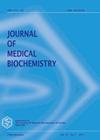The influence of various sample storage conditions and sample microbial contamination on concentrations of routine biochemical parameters
IF 1.5
4区 医学
Q4 BIOCHEMISTRY & MOLECULAR BIOLOGY
引用次数: 0
Abstract
Background: The pre-analytical (PA) phase is the most vulnerable phase of laboratory testing procedure, with critical procedures-collection, handling, sample transport, and time and temperature of sample storage. The aim of this study was to examine if different anticoagulants, storage conditions, and freeze-thaw cycles (FTCs) influence the concentrations of basic biochemical parameters. In parallel, the presence and the effect of sample microbiological contamination during routine laboratory work were examined. Methods: Two plasma pools (EDTA, and sodium-fluoride/potassium oxalate plasma (NaF)) were stored at +4C˚/-20˚C. Total cholesterol (TC), glucose, triglycerides (TG), urea, total protein (TP), and albumin concentrations were measured using Ilab 300+. Sample microbiological contamination was determined by 16S rRNA sequence analysis. The experiment encompassed a 5 day-period: Day 1–fresh sample, Day 2–1st FTC, Day 3–2nd FTC, Day 4–3rd FTC, Day 5–4th FTC. The appearance of bacteria in two consecutive samples was the experiment's endpoint. Results: During 4 FTCs there were no changes in plasma urea concentrations. Glucose was stable in EDTA+4˚C and NaF- 20˚C until the 3rd FTC (P=0.008, P=0.042, respectively). Changes in protein concentrations followed the zig-zag pattern. TG concentrations changed significantly in the EDTA-20˚C sample after 1st and 4th FTCs (P=0.022, P=0.010, respectively). In NaF samples no contamination was observed during 4 FTCs. Conclusions: Urea and glucose concentrations were robust. Changes in lipid and protein concentrations after FTCs follow complex patterns. Bacterial growth was not observed in NaF plasma samples. This can promote NaF use in analytical procedures in which microbiological contamination affects the quality of analysis.各种样品储存条件和样品微生物污染对常规生化参数浓度的影响
背景:分析前(PA)阶段是实验室检测程序中最脆弱的阶段,其关键程序包括样本采集、处理、样本运输以及样本储存的时间和温度。本研究旨在探讨不同的抗凝剂、储存条件和冻融循环(FTC)是否会影响基本生化指标的浓度。同时,还考察了常规实验室工作中样本微生物污染的存在及其影响。 研究方法两个血浆池(EDTA 和氟化钠/草酸钾血浆 (NaF))分别储存在 +4C˚/-20˚C 温度下。使用 Ilab 300+ 测量总胆固醇 (TC)、葡萄糖、甘油三酯 (TG)、尿素、总蛋白 (TP) 和白蛋白的浓度。通过 16S rRNA 序列分析确定样品的微生物污染情况。实验为期 5 天:第 1 天为新鲜样品,第 2-1 天为 FTC,第 3-2 天为 FTC,第 4-3 天为 FTC,第 5-4 天为 FTC。连续两个样本中出现细菌即为实验终点。 结果:在 4 次 FTC 期间,血浆尿素浓度没有变化。葡萄糖在 EDTA+4˚C 和 NaF- 20˚C 中保持稳定,直至第 3 次 FTC(分别为 P=0.008 和 P=0.042)。蛋白质浓度的变化遵循 "之 "字形模式。EDTA-20˚C 样品中的 TG 浓度在第 1 次和第 4 次 FTC 后有明显变化(分别为 P=0.022 和 P=0.010)。在 NaF 样品中,4 次 FTC 期间未观察到污染。 结论尿素和葡萄糖浓度稳定。FTC 后脂质和蛋白质浓度的变化模式复杂。在 NaF 血浆样本中未观察到细菌生长。这有助于在微生物污染影响分析质量的分析过程中使用 NaF。
本文章由计算机程序翻译,如有差异,请以英文原文为准。
求助全文
约1分钟内获得全文
求助全文
来源期刊

Journal of Medical Biochemistry
BIOCHEMISTRY & MOLECULAR BIOLOGY-
CiteScore
3.00
自引率
12.00%
发文量
60
审稿时长
>12 weeks
期刊介绍:
The JOURNAL OF MEDICAL BIOCHEMISTRY (J MED BIOCHEM) is the official journal of the Society of Medical Biochemists of Serbia with international peer-review. Papers are independently reviewed by at least two reviewers selected by the Editors as Blind Peer Reviews. The Journal of Medical Biochemistry is published quarterly.
The Journal publishes original scientific and specialized articles on all aspects of
clinical and medical biochemistry,
molecular medicine,
clinical hematology and coagulation,
clinical immunology and autoimmunity,
clinical microbiology,
virology,
clinical genomics and molecular biology,
genetic epidemiology,
drug measurement,
evaluation of diagnostic markers,
new reagents and laboratory equipment,
reference materials and methods,
reference values,
laboratory organization,
automation,
quality control,
clinical metrology,
all related scientific disciplines where chemistry, biochemistry, molecular biology and immunochemistry deal with the study of normal and pathologic processes in human beings.
 求助内容:
求助内容: 应助结果提醒方式:
应助结果提醒方式:


